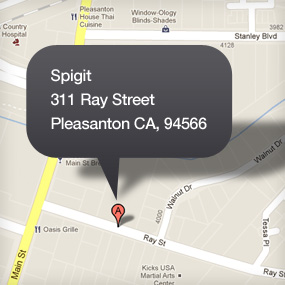
It may come as no surprise that 98% of business and government executives say innovation will be critical to the success of their organizations over the next five years. I suppose that 2% compromise the hot dog stand chefs in New York City.
Many believe that innovation is by nature a social activity, something that results from creative collisions, idea exchange and new social stimuli. We’ve seen the rise of crowdsourced innovation in recent years with companies like Kickstarter, IndieGoGo, GOOD Magazine and OneSky paving the way.
Spigit, a “crowd innovation company” is using idea management technology that helps employees innovate where they work, in addition to their every day functions. Spigit says its helping companies harness the outliers in their workforce, and move R&D efforts past the core.
A creator, strategist and athlete, Paul Pluschkell, CEO and founder of Spigit, is nothing short of dynamic. For over 18 years, Pluschkell has founded and led successful and profitable high-tech strategic organizations for both private and public companies. We caught up with Pluschkell to discuss the current trend of crowdsourcing and if it really works for innovation.
 CBM: In the past, who did humanity rely on for innovation?
CBM: In the past, who did humanity rely on for innovation?
Paul Pluschkell: Historically, humanity relied on a select few – the chosen ones. This small group was willing to risk everything to move us forward, technologically and socially. Even in more recent years, innovation has been an activity reserved for a core group of R&D experts, elite group of decision-makers, or the irregular individual who has the risk appetite necessary to innovate.
However, that doesn’t mean people lack creativity or insight – and technology is becoming a new outlet to capture that.
CBM: How has technology changed this?
PP: Today, technology is approachable, meaning it’s easier to access and work with, which results in a much greater percentage of early adopters. Through the progression of the web to social platforms, for the first time in human history, we are seeing the emergence of digital commons – platforms where the ethos and the expectation is that you participate.
For innovation, these digital commons are solving a historical issue that limited progress –the scale of interaction. It was never possible to put thousands of people in the same room and have them work together to find the golden egg. It was impossible to know others’ ideas, and there was no way to harness the rich, cognitive diversity of people. These digital commons have been a watershed development in enabling and accelerating a broader innovation approach. Today’s technologies are enabling companies to not only spread a wider net in their search for innovation, but also to encourage collaborative behaviors that evolve raw ideas into well thought out concepts that will deliver value to the organization.
CBM: What are the downsides of relying on crowdsourcing for innovation?
PP: As far as I can tell there is only one serious drawback – and that is if you ask for a crowd’s participation, you need to be prepared to act. Engagement and desire to participate needs to be fueled, and nothing turns crowds off more than if you simply ignore them.
CBM: What are the upsides of using a crowd as a service?
PP: Consider all of the things a crowd can do – crowd innovation and ideation, crowd problem solving crowd labor, crowdfunding, crowd design and identification and community building to name a few. Why wouldn’t you ask the crowd?

We’ve seen it work on Who Wants to Be a Millionaire, with the crowd almost always leading to the right answer. Crowds multiply the force and possibility of what we do, especially when it comes to intellectual and knowledge economies. Collectively, a crowd offers scale and diversity of thinking that provides faster problem-solving with more knowledge and expertise infused in the process. There are more ideas to choose from, and more powerful ones than when they originate and end with a limited group of people.
Another benefit is the engagement crowd participation drives. By providing transparency and visibility within your organization, employee morale and customer loyalty stand to improve significantly.
CBM: What are 5 crowdsourcing best practices?
PP:
- Set goals. Articulate the problem and give your audience a specific challenge or clarity around the end goal. Framing the questions is vital to success.
- Practice cross-fertilization. Executive sponsorship is important at the onset to gather crowds, but don’t limit participants to a single area of expertise or department within a business. Bringing together different thinkers results in bigger, better ideas.
- Make it fun. There needs to be a social recognition and a game quality to make what is ultimately a problem-solving task attractive to participants. Integrate game mechanics and voting, or prizes to motivate the crowd.
- Be committed. Be prepared for a continuous feedback loop – to provide an answer, take action or just simply acknowledge the crowds contributions.
- Allocate back-end resources. On the front-end, things like communication and motivation are critical. Once the ideas start rolling in, there needs to be curation and filtering, along with plans to put the contributions into action.

CBM: What are 5 tips for employees to be able to innovate where they work in addition to everyday functions?
PP:
- Go for it. You have a lot to offer – jump in. Make innovation a part of your every day routine.
- Don’t limit yourself to your job description. Embrace opportunities and look for chances to leave your comfort zone.
- Collaborate. Tap into coworkers and friends. Get input from the crowd on your idea to take it to the next level.
- Speak up, even if it means risking failure. You’ll never know if your idea has potential if it isn’t shared.
- Learn from others and make new connections.
 CBM: What are 5 ways managers can help their employees innovate?
CBM: What are 5 ways managers can help their employees innovate?
PP:
- Give employees the time, tools and resources needed. Create a culture of innovation through learning, sharing and continual support for creativity and co-creation.
- Put a spotlight on innovation. Create a challenge, increase communication around idea initiatives and make it a goal.
- Practice it yourself. Hold brainstorms and group feedback sessions to help surface new ideas.
- Motivate employees to participate with social or public recognition.
- Make it safe to present ideas and make far reaching suggestions.
CBM: What are the 3 most important characteristics of an innovative culture?
PP:
- Executive sponsorship – it’s not just checking a box off or a nod of the head. The people at the top of an innovative culture walk the walk.
- Innovation requires systematic processes, structure and stimuli. Innovative cultures have the tools and education in place to make it work.
- It’s a daily part of everything you do. It becomes part of company DNA.
CBM: Have you heard of the company Prehype? What do you think of it and how is Spigit taking a different approach?
PP: Prehype is an interesting concept. The fact is that companies have the creative people ready to engage. However, management needs to create a culture that unearths those people, the ‘intrapreneurs’, through education, tools and the ability to take action. That will give a company the best chance of survival in today’s hypercompetitive environment.
CBM: What are a few small, but very important and often overlooked qualities that a company needs to be innovative?
PP: I can’t stress how important it is to analyze the community metrics – from the topics the crowd is most passionate about to what motivates an individual to participate. Companies need to monitor their crowds and make continuous improvements, whether incremental or radical, to create the highest levels of engagement possible.
 CBM: How important are things like company healthcare, vacation days and competitive pay to keep a company innovative?
CBM: How important are things like company healthcare, vacation days and competitive pay to keep a company innovative?
PP: Innovation is not limited to products. The best companies recognize that to be innovative in their products and services, they must also embrace innovation in management, technology and everything that they do. Workplace perks and competitive employer tactics contribute to innovation by keeping employees engaged and passionate. At Spigit, we’ve set aside a $10,000 budget for employees to personalize their workspace.
Get the TNW newsletter
Get the most important tech news in your inbox each week.





